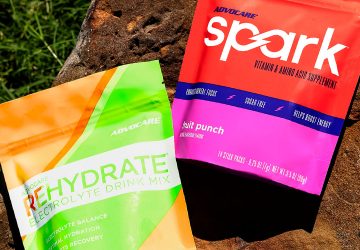“How do I transform my eating habits for good?” is a question many people ask themselves at the beginning of each new year. With magazine ads and celebrities touting their diet plans, detoxes and strategies, it can often be confusing to know which voice to listen to and which to drown out. Not to mention, the key to transforming your eating habits for good means that it’s sustainable for the long-haul, not just for the next month. So, if the plan you are reading about doesn’t seem doable long-term, then that is more of a diet rather than a lifestyle change. If you want results that last, you have to look at changing habits and figuring out ways to incorporate those into your daily life.
Follow these 10 steps to set yourself up for success:
- Live by the 80/20 Rule – Reality Check! Healthy eating has to fit into your lifestyle, or you will never be able to maintain it. While veggies should fill up a good portion of your plate, it is not realistic to say that you will never eat cake, ice cream or chips and queso again, so it is important to understand how to make all foods fit. Think of living by the 80/20 Rule. This means that 80 percent of the time you focus on eating nutrient-rich foods like whole grains, lean protein, healthy fat, fruits and veggies as well as exercising. Then, 20 percent of the time you can include foods that are higher in calories and lower in nutrients. You know, the ones that taste so good, but that you shouldn’t consume every day for your waistline and health’s sake!
- Watch the Nutrient Timing Clock – Nutrient timing is key to healthy eating as if you skip meals, you set yourself up to feel “starving” and likely to make less optimal food choices. The goal is to fuel your body with nutrient-rich foods every few hours throughout the day. Eating regularly helps stabilize your blood sugar, and thus your energy levels, as well as help you feel hungry and satisfied versus starving and stuffed! So, watch the clock and set the alarm for nutrient timing!
- Pay Attention to Portions – Plates and portion sizes are bigger these days! Your goal is to think of eating until you are not hungry, instead of until you are full. While this is easier said than done, pre-plating your food, portioning snacks into baggies and asking for a to-go container at the restaurant can help you have better portion control. A good rule of thumb is to take your plate and make half of it veggies, one-fourth lean protein and one-fourth whole grains; then if you are hungry, go back for more veggies.
- Go Whole with Grains – Grains, or carbohydrates, are one of your body’s main sources of energy. Your goal is to choose more whole grains like whole wheat, oats, quinoa, farro, couscous, etc. Whole grains have more fiber, which helps with heart and gastrointestinal health, while also helping you stay full a little longer. A small portion of grains at every meal can help stabilize your energy levels throughout the day.
- Power the Day with Protein – Protein plays a variety of roles in the body including building lean muscle mass and slowing down digestion. High quality protein sources are animal foods (including dairy and eggs) along with soy and quinoa. You can also find protein in plant foods like beans, legumes, nuts and seeds. Pairing protein with a high-fiber carbohydrate at each meal and snack will help stabilize your blood sugar and energy levels over the course of the day. Eggs and oatmeal, chicken and rice, salmon and sweet potato and cheese with whole grain crackers are all great examples.
- Garnish Your Meals with Healthy Fat – Unsaturated fats like fatty fish, nuts, nut butters, seeds, avocado and unsaturated oils are essential for heart health. Because fat yields more calories per grams than carbohydrates and protein do (9 calories per gram as compared to 4), think of garnishing meals and snacks with fat like nuts in your oatmeal or avocado on your wrap. Fat can help with satiety and keeping you full longer after a meal.
- Fill Up on Veggies and Fruit – Full of fiber and nutrients, eat as many vegetables and fruit as you can! It is important to note, however, that fruit is a sugar and technically falls in the carbohydrate category. So, work on eating more veggies! Each color packs a different nutrient package so aim to get a variety of colors.
- Hydrate with the Right Fluids – Hydration is a key component to healthy eating. Ideally your goal is to drink water, but other low-calorie beverages count as well. Be sure that you are not adding sugar calories with your fluids from things like soda, sweet tea, fancy coffee beverages, juices and other sugar-sweetened beverages, as those can have a negative effect on health and your waistline. Plus, they typically don’t make you feel full.
- Read Food Labels over Marketing Ads – Examining the food label can help you make more educated decisions at the grocery store. Don’t be persuaded by the advertisement on the package because sometimes it doesn’t tell the whole nutrient story. Take time to look at the ingredients, as well as the calories, carbohydrates, fiber, protein and fat grams to ensure you are making a nutrient-rich choice.
- Have an Eating Game Plan – Just like in a sports game or preparing a business proposal, having a plan is essential to success. Thinking and planning in advance is key to healthy eating. If you are going out to eat, check out the nutrition facts before you go. Have a busy week at work? Be sure to pack healthy snacks to fuel your day. Planning sets you up to make better decisions and makes healthy eating easier! Remember, a goal without a plan is just a wish, so get a plan in place!
 Amy Goodson, MS, RD, CSSD, LD is a registered dietitian and Certified Specialist in Sports Dietetics. She focuses on overall health, wellness and sports nutrition. Amy has worked with the Dallas Cowboys, Texas Rangers, TCU Athletics, Ben Hogan Sports Medicine and more. She is a co-author of Swim, Bike, Run, Eat and nutrition contributor to retired NFL Player Donald Driver’s book, The 3-D Body Revolution. She is a writer for Women’s Running Magazine and is the owner of RD Career Jump Start, a business designed to help dietetic students, interns and new registered dietitians determine and take the steps necessary to reach their dream career.
Amy Goodson, MS, RD, CSSD, LD is a registered dietitian and Certified Specialist in Sports Dietetics. She focuses on overall health, wellness and sports nutrition. Amy has worked with the Dallas Cowboys, Texas Rangers, TCU Athletics, Ben Hogan Sports Medicine and more. She is a co-author of Swim, Bike, Run, Eat and nutrition contributor to retired NFL Player Donald Driver’s book, The 3-D Body Revolution. She is a writer for Women’s Running Magazine and is the owner of RD Career Jump Start, a business designed to help dietetic students, interns and new registered dietitians determine and take the steps necessary to reach their dream career.
With a bachelor’s degree in communications and a master’s degree in exercise and sports nutrition, Amy is passionate about marrying the two to provide quality, science-based nutrition information through speaking, media, writing and consulting. Amy consults for various companies, food brands and organizations and serves as a media dietitian for RDTV where she does food and nutrition TV segments nation-wide. Amy has over 600 media placements in a variety of TV, radio and print outlets.






